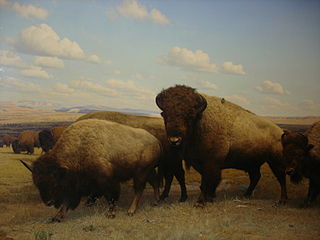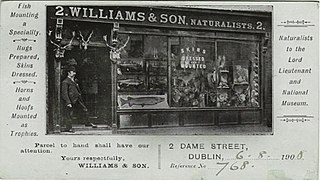 W
WTaxidermy is the art of preserving an animal's body via mounting or stuffing, for the purpose of display or study. Animals are often, but not always, portrayed in a lifelike state. The word taxidermy describes the process of preserving the animal, but the word is also used to describe the end product, which are called taxidermy mounts or referred to simply as "taxidermy". The word taxidermy is derived from the Greek words taxis and derma. Taxis means "arrangement", and derma means "skin". The word taxidermy translates to "arrangement of skin".
 W
WBird collections are curated repositories of scientific specimens consisting of birds and their parts. They are a research resource for ornithology, the science of birds, and for other scientific disciplines in which information about birds is useful. These collections are archives of avian diversity and serve the diverse needs of scientific researchers, artists, and educators. Collections may include a variety of preparation types emphasizing preservation of feathers, skeletons, soft tissues, or (increasingly) some combination thereof. Modern collections range in size from small teaching collections, such as one might find at a nature reserve visitor center or small college, to large research collections of the world's major natural history museums, the largest of which contain hundreds of thousands of specimens. Bird collections function much like libraries, with specimens arranged in drawers and cabinets in taxonomic order, curated by scientists who oversee the maintenance, use, and growth of collections and make them available for study through visits or loans.
 W
WThe conservation of taxidermy is the ongoing maintenance and preservation of zoological specimens that have been mounted or stuffed for display and study. Taxidermy specimens contain a variety of organic materials, such as fur, bone, feathers, skin, and wood, as well as inorganic materials, such as burlap, glass, and foam. Due to their composite nature, taxidermy specimens require special care and conservation treatments for the different materials.
 W
WDuring the 20th century, Deyrolle was a Parisian institution for natural sciences and pedagogy. It is one of the best known companies of entomology and taxidermy of Paris. Today, Deyrolle is a shop and a cabinet of curiosities open to the public, a reference in the field of taxidermy, entomology and natural sciences, whose vocation is to show the beauty of Nature. Deyrolle is also involved in pedagogy and art.
 W
WRahmat International Wildlife Museum & Gallery is a natural history museum in Medan, Indonesia. The museum displays various collections of wildlife from the smallest to the largest according to the habitat. After the development was completed in October 2007, the Museum & Gallery has an area of 2970 m² building.
 W
WThe Torrington Gopher Hole Museum, located in Torrington, Alberta, features stuffed gophers posed to resemble townspeople. It was opened in 1996.
 W
WVan Ingen & Van Ingen, simply Van Ingen, or Van Ingen of Mysore (1900–1999) were Indian taxidermists located in Mysore, South India, best known for their tiger and leopard taxidermy trophy mounts. A History of Taxidermy. Art, science and bad taste states that Van Ingen factory processed more than 43,000 tiger and leopard trophies in less than 90 years of operation. Van Ingen & Van Ingen taxidermy today are still found throughout the world in the form of head mounts, full mounts, flat animal rugs, and rug mounts with heads attached.
 W
WWilliams & Son, Dublin was a taxidermy firm which operated in Dublin, Ireland from the late 1860s to the early 1940s.